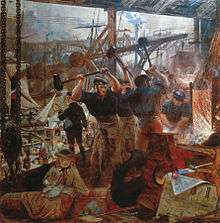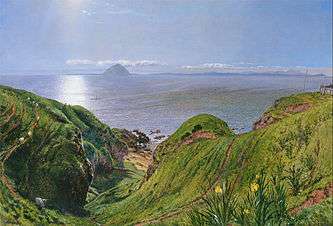William Bell Scott

William Bell Scott (12 September 1811 – 22 November 1890) was a Scottish artist in oils and watercolour and sometimes printmaking. He was also a poet and art teacher, and his posthumously published reminiscences give a chatty and often vivid picture of life in the circle of the Pre-Raphaelites; he was especially close to Dante Gabriel Rossetti.
After growing up in Edinburgh, he moved to London, and from 1843 to 1864 was principal of the government School of Art in Newcastle upon Tyne, where he added industrial subjects to his repertoire of landscapes and history painting. He was one of the first British artists to extensively depict the processes of the Industrial Revolution. He returned to London, working for the Science and Art Department until 1885.[2]
He painted a cycle of historical subjects mixed with scenes from modern industry for Wallington Hall in Northumberland (now National Trust), his best known works, and a purely historical cycle for Penkill Castle in Scotland. He did not paint many portraits, but his striking portrait of his friend Algernon Charles Swinburne is the iconic image of the poet. His etchings were mostly designed to illustrate his books.
Personal life
The son of Robert Scott (1777–1841), the engraver, and brother of David Scott, the painter, he was born in Edinburgh.[3] While a young man he studied art and assisted his father, and he published verses in the Scottish magazines.
In 1837 he went to London, and in 1839 he married Letitia Margery Norquoy; the marriage was childless. In London, he became sufficiently well known as an artist to be appointed in 1844 master of the government school of design at Newcastle-on-Tyne. He held the post for twenty years, and did work in organizing art-teaching and examining under the Science and Art Department.[3] It was there that he gained as a pupil Alice Boyd, the sister of the then-laird of Penkill Castle in Scotland. In 1860, Bell Scott visited Penkill Castle and began a liaison with Alice that would last until his death at Penkill in 1890. Although unhappily married, Bell Scott refused to cause a scandal by leaving his wife, and a workable ménage à trois was established: Alice spent winters with William and Letitia in London, while they came to Penkill in the summers.[4]
Artwork


In addition to oil paintings, Bell Scott did much decorative work, notably at Wallington Hall, in the shape of eight large pictures illustrating Border history, with life-size figures, supplemented by eighteen pictures illustrating The Ballad of Chevy Chase in the spandrels of the arches of the hall. For Penkill Castle, he executed a similar series, illustrating James I's The Kingis Quair.
In Newcastle, Scott was visited by all the Rossetti family, and Dante Gabriel Rossetti painted Maria Leathart's portrait at Scott's house 14 St Thomas' Crescent (plaque erected 2005). Algernon Charles Swinburne, who wrote two poems to Scott, spent much time with him in Newcastle after being sent down from Oxford.
After 1870 Scott was much in London, where he bought a house in Chelsea, and he was an intimate friend of Rossetti[3] and in high repute as an artist and an author. He was, however, at daggers drawn with John Ruskin.[5]

His poetry, which he published at intervals (notably Poems, 1875, illustrated by etchings by himself and Alma-Tadema), recalled Blake and Shelley, and was considerably influenced by Rossetti; he also wrote several volumes of artistic and literary criticism, and edited Keats, L.E.L., Byron, Coleridge, Shelley, Shakespeare and Scott.
He resigned his appointment under the Science and Art Department in 1885, and from then until his death he was mainly occupied in writing his reminiscences, Autobiographical Notes, which were published posthumously in 1892, with a memoir by Professor Minto. It is for his connection with Rossetti's circle that Bell Scott will be chiefly remembered.[3]
References
- 1 2 National Portrait Gallery, London
- ↑ Andrew Wilton & Anne Lyles, The Great Age of British Watercolours, 1750–1880, p. 321, 1993, Prestel, ISBN 3791312545
- 1 2 3 4
 Chisholm, Hugh, ed. (1911). "Scott, William Bell". Encyclopædia Britannica (11th ed.). Cambridge University Press.
Chisholm, Hugh, ed. (1911). "Scott, William Bell". Encyclopædia Britannica (11th ed.). Cambridge University Press. - ↑ Hermes. "William Bell Scott, Alice Boyd, and Penkill". Pre Raphaelite Art website.
- ↑ Tim Hilton, John Ruskin (2002) p.644. 'The publication of Our Sketching Club gave an opportunity to ... Ruskin's old enemy, to write a hostile review in which he repeated many of the his earlier criticisms of The Art of Drawing.'
External links
 "Scott, William Bell". Dictionary of National Biography. London: Smith, Elder & Co. 1885–1900.
"Scott, William Bell". Dictionary of National Biography. London: Smith, Elder & Co. 1885–1900. - William Bell Scott biography
![]() Media related to William Bell Scott at Wikimedia Commons
Media related to William Bell Scott at Wikimedia Commons
- William Bell Scott at BBC Your Paintings (in partnership with the Public Catalogue Foundation)
- William Bell Scott at Future Museum, South West Scotland.